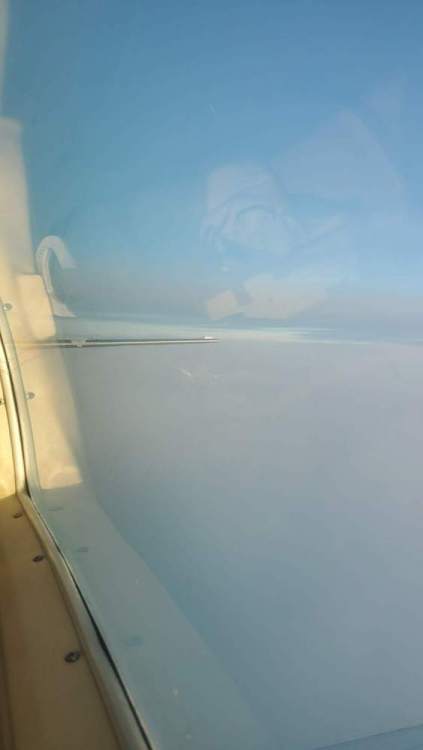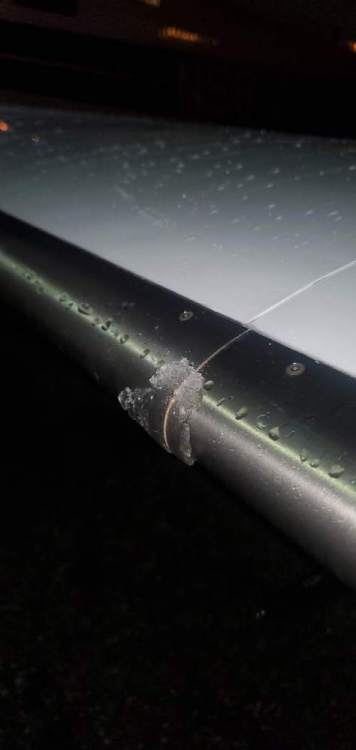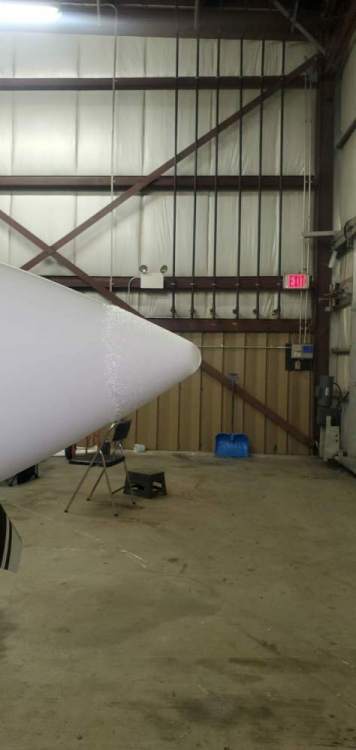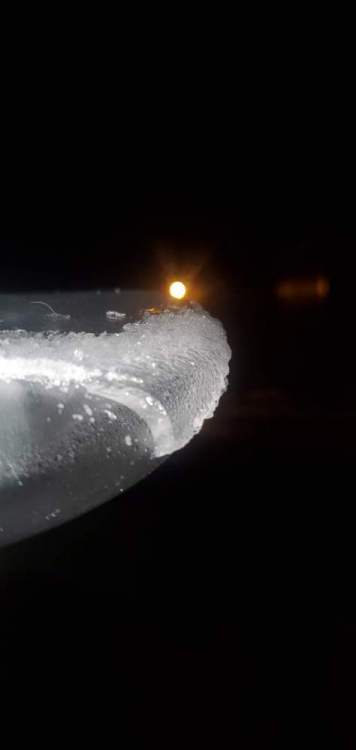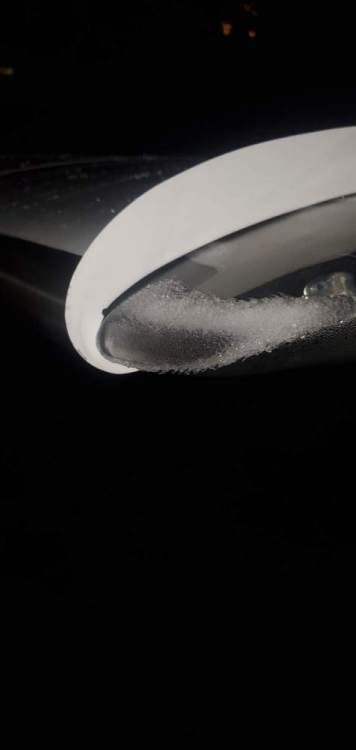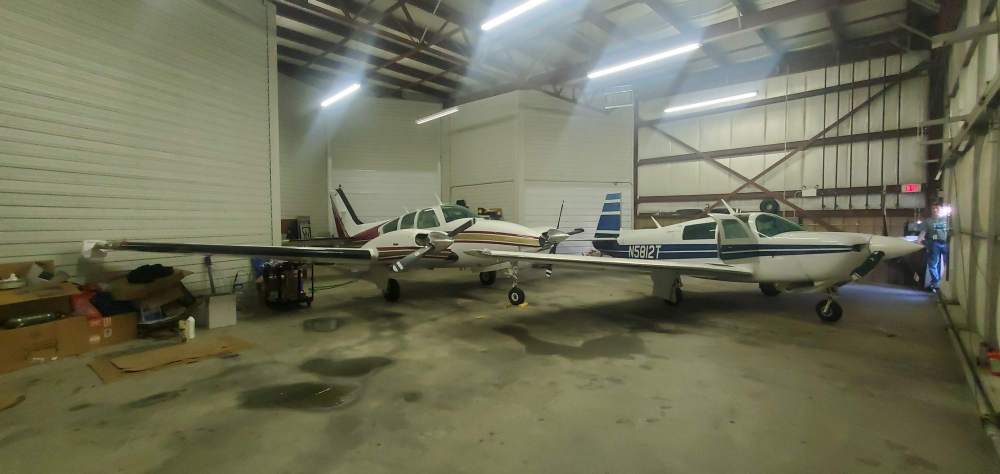
Tim Jodice
Supporter-
Posts
530 -
Joined
-
Last visited
-
Days Won
3
Content Type
Profiles
Forums
Blogs
Gallery
Downloads
Events
Store
Everything posted by Tim Jodice
-
I would definitely buy one again. it had about 450-500 hours on it. It was after heavy rain. I was going to sun n fun anyway and in the past I didn't park at LAL so parking in Deland was not a big deal. This is the picture I sent them and they said that they would (and did) repaint it.
-
I dont have the 201 anymore. I think they mean shipping to Florida. I had paint issues as well and they told me the samething. I ended up going to sun n fun, left the plane with them and avoided the R&R labor and shipping.
-
Yes. I would buy one again.
-
Not a typo for some reason the lines crossed at about 2300. maybe because I did the stock prop at 9500 and the engine is making less power. The perceived noise level is unmistakably lower at all but lowest RPMs.
-
How Much Did You Fly Your Mooney This Year?
Tim Jodice replied to V1VRV2's topic in General Mooney Talk
283 commuting to work. -
The systems FIKI or not work awesome on Mooneys. In addition to what others have said the panels are different. The inadvertent system has 5 panels per wing and two on each side of the horizontal stabilizer, FIKI systems have 3 per wing and one per side of the tail. If you look at all of the foward facing surfaces on a Mooney there is very little unprotected. About an inch at the wing root, about 2 inches at the bottom of the vertical stabilizer and the wing tips. where it is not obvious is where the panels meet. Some airplanes Cirrus being a great example have substantial differences between inadvertent and FIKI. A quick walk around a FIKI and then an inadvertent Cirrus it is very obvious that they changed alot from the wing roots, tips not being protected and probably the most important is the elevator counterweight. Not that ice under any circumstances is good but most airplanes can carry some ice. Few do well with a few extra pounds of weight on a counter weight of a flight control.
-
where is it?
-
I forgot why but I know bore size has a lot to do with detonation limits. Most aircraft engines are around a 5 inch bore while cars are around 3-3.5 bore. Maybe someone he smarter than me can explain it.
-
No I did have an issue finding what I wanted. So few people like Skymasters so it keeps the value down and available. The one I bought was only about 60 miles away. It had everything I wanted in the panel, Riley Rocket mods the most important one being the intercoolers and approximately mid time engines. The Baron (N20148) is a 1978 B55 with 470s also know as a baby Baron for the short nose and small engines. Awesome airplane, 1680 Useful load and it will do 190ishTAS if you want it to but I fly it at 175 on 22 GPH total. Fastest trip ever was a few week ago, 34 min from MHT to ACK. Max cruise power and a tail wind. it normally takes 45-50 minutes normal winds and a more sedated power setting. I gave been trying to get together with @MarkD34M to race his Ovation and see how much more fuel the Baron uses to do the same speed.
-
I would say I am moving laterally for two specific reasons. When I bought my Mooney It was a perfect fit for what I needed and that is to bring 2 sometimes 3 people plus a lot of baggage 120 miles each way for the least amount of money. Well business continues to grow and I need to bring more people more parts. To address that problem I bought a Baron with three other people and it works great I use it during the week and they use it nights and weekends. Payload problem solved I planned to use the Baron mostly during the peak season (May-September) and the Mooney the rest of the time. Well I am 3 years in now and while it does slow down in the winter it doesn't slow down enough to only need 2 people. So to this day I continue to use the Baron most of the time. Then came the next and more challenging issue. I started noticing a ringing in my right ear and I didn't thing much of it in the beginning but like most things it continued to get worse. I couldn't figure out why, sometimes it was more noticeablethan others. I figured 41 was a bit young to get tinnitus but everyone is different. I went to see an ear doctor and found out I don't have tinnitus but likely earlier in life I damaged my right ear. Fixing cars my whole life that isn't hard to believe. I told him what I do for work today and that I fly everyday to get there. He said that flying is likely your problem that provokes it to ring today. I said I have plenty of friends (one that is twice my age) that fly frequently and don't have any issues. He asked, how many of them fly 10 times a week for the past 3 years? I said...... He told me, no one is surprised when there ears ring when they hear something very loud, well it is nothing more than pressure and you do that every time you fly. I stay below 5000 95% of the time and 2500 when it is VFR. there have been a few weeks when almost every day was VFR and when I never get above 2500 the ringing goes away. I currently love what I do and don't want to stop but I don't want to do anymore damage to my ear. I bought a pressurized Cessna P337 Skymaster. After speaking to people that own one It sounded like a perfect fit. With only a little over 300 pressurized skymasters made few people have flown one and even less have own one. I am going to miss the Mooney. It never failed me during the 650 or so hours I put on it. If there is anyone who want to go for a ride in one call me. I don't mean just the people looking to buy it but anyone who would like to see and fly one. A pet peeve of mine is when someone says "I heard from a friend that Mooneys are (fill in the blank)". I ended up liking and buying a Mooney because someone took me flying in their Mooney and I saw first hand that people that talk bad about a Mooney are wrong. I would love do for someone what he did for me.
-
M20J upgrade from 2 Blade McCauley to 3 Blade MT Prop
Tim Jodice replied to DEGWS's topic in Modern Mooney Discussion
I agree with everything here. Based on my experience the original propeller is all about top speed. Better take off performance doesn't sell Mooneys, Going 2.05 knots faster does. Comparing equal technology propellers it makes sense that a 3 blade would give up some top speed in exchange for the benefits any 3 blade propeller gives. Like everything in avation there is no free lunch so in order to gain all of the benefits with no performance loss. It is going to co$t you. I paid $14K a year ago. -
M20J upgrade from 2 Blade McCauley to 3 Blade MT Prop
Tim Jodice replied to DEGWS's topic in Modern Mooney Discussion
I made this when I got mine. -
Agreed there are exceptions, the F model I fly has 1018UL. With the exception of some trainers most common light twins have 15-1600 UL.
-
A few things to be fair to 310s and twins in general, Not all parts cost 3 times. in fact many of the parts are the same and when you get to the airframe they only have one. If all Mooneys had 4 cylinder engines then yes there would be 3 times the cylinders. At the other end of Mooneys a quick look on Airpower shows you can buy 2 factory IO-470s for a 310 or Baron for one engine on a Bravo. A small engine (IO-470) 310/baron usually burns 25-28 GPH ROP, I personally run a Baron at 22 LOP. compared to a J typical 10GPH Close to 3 only if you running the twins at a high power. 20% faster in cruise but they climb at a much higher rate typically going faster as well. Useful load is the big one and the only reason I fly a twin. Most Mooneys have around 900 useful load. yes there are the few around 1000 and some very rare examples like striped Eagles that approach 1100. Most small engine Barons 310s have 15-1600 Useful and some rare examples around 17-1800. They do need to use up some of it to carry the extra fuel needed but they still have a better useful load. At most twice the cost to repair from a gear up. while you do have 2 engines to fix you still only have one airframe to repair the sheet metal, flaps, etc and that can be a big part of the bill. The reason I bring all this up is because someone reading MooneySpace my want to buy a twin and unless you are comparing a Mooney 201 to a turbo 310 or 340 it doesn't cost three times as much to run. I learned all of this from owning a 201, partner in a Baron along with other friends that own twins.
-
It sounds like a turbo is almost a must.
-
Or a second battery that it's sole purpose is to feed one system. No manual override to tap in to it to run other equipment. The battery needs to be sized that it lasts longer than full fuel lasts.
-
$1000 "climate" regulated landing fees in Massachusetts?
Tim Jodice replied to Urs_Wildermuth's topic in General Mooney Talk
The elite would be pissed. It is hard enough as it is to get working people there FOR the elite. Get rid of them who is going to cater to the elite? -
$1000 "climate" regulated landing fees in Massachusetts?
Tim Jodice replied to Urs_Wildermuth's topic in General Mooney Talk
Where does it say $1,000? -
$1000 "climate" regulated landing fees in Massachusetts?
Tim Jodice replied to Urs_Wildermuth's topic in General Mooney Talk
He is clearly going after affluent people. Does he consider the local economy? people that live/visit Nantucket and Martha's Vinyard aren't exactly living on a welfare check and food stamps. It likely wouldn't stop the very wealthy but people with less than a G650 might think twice before going there for fun. I would. I am hoping that he was smoking crack when he wrote it and it gets thrown out by someone who looks at the big picture. -
-
I am in the "I did not buy a Mooney to go slow camp" that said I try to be LOP when possible. Unless the is a reason to be high I stay between 4-8K feet. that typically allows me to make 75-85% (10-11GPH) power LOP. In my experience 20 degrees LOP is the sweet spot regarding max power while keeping the cylinders temp around 380. I run ROP when the density altitude won't let me make 75% then I take what I can get. Playing with RPM I find 2600-2700 is best. It does seem logical that slower is better for both reduced frictional losses in the engine and increased propeller efficiency but in my experience it is negligible if at all measurable. I am not an engineer but my guess is in the big picture both of those reductions in efficiency are very small relative to better BSFC running LOP. Pick any power setting from the book note the speed and then go LOP and raise the rpm as needed to return to the same speed. In my experience there has never been a combination that is more efficient running a lower RPM ROP than a higher RPM LOP. It is only 1 GPH less at 75% but it it is a free 10% increase in MPG. Now let's throw in some temperature related reality. Book numbers seem to be the notorious 50 ROP. If you are going to run high power ROP and want to have the same CHTs as LOP then you need even more fuel than book. I find it takes 100-120 ROP or about 13 GPH to keep them around 380. That eeks out about 3 maybe 5 knots. However if the density altitude is high (9K+)and cylinders are easy to keep cool I set up 50 ROP. I will post some pictures later.
-
Why was the IO-720 a failure?
Tim Jodice replied to Tim Jodice's topic in Miscellaneous Aviation Talk
Pretty much but, It is smaller with more power=speed/range A larger engine making more power on the same gas through efficiency. while the engine is heavy it means the power density is lower and is likely to have a better a service life. getting to the front seat of a PA-46 is a challenge for some impossible for others. I have never measured it but it looks like it is wider than it is tall. You step down in to a M22. Again pipe dream but it would be nice if there was another pressurized piston single available. -
Why was the IO-720 a failure?
Tim Jodice replied to Tim Jodice's topic in Miscellaneous Aviation Talk
This is what I think about when I am not doing anything. Imagine this, working with what already exists starting with a M22 and a IO-720. Do 201 like upgrades to the M22, bring it up to todays standards, raise the pressure differential to 5.5-6PSI, increase fuel capacity to 130 gallons and up the gross weight to 4300 pounds. Turbo normalize the engine Keeping it at its regular 400HP with high compression pistons. Why you ask. Regardless if you are Boeing or Mooney a clean sheet aircraft is extremely expensive. As every manufacturer has shown it is WAY less expensive to modify what you have. Starting with a M22 that has never been updated from its original design likely has a lot low hanging fruit that would improve the airplane, aerodynamic clean up etc. Increasing the pressure differential would add weight but would make it more comfortable at 25,000 feet. If they can take original short body C/E with a gross weight of 2575 to 3368 (30% increase) with structural modifications I think that they could take a M22 with a 3680 to 4300. (16% increase) Adding a bigger engine higher pressure differential and all the wonderful (heavy) things like A/C and TKS that brand new aircraft have you would add say 450 pounds to the original 2440 then you would have a useful load of about 1400 pounds or 620 full fuel. Increasing fuel capacity simply (I think) requires sealing off more bays in the wing. Now the engine. using the successful Bonanza TAT turbo normalized mod as a reference. they typically run 17GPH LOP or 85% (255HP) power running cooler than a factory turbo Bonanza making 65% power. According to people on Beechtalk they have good reports on engine life. Apply a similar well made turbo system to a 720 and you have 340HP burning about 22-23 GPH in cruise. Maybe 250TAS@ 25000 feet? With 130 gallons of fuel you would have about 5.5 hours of gas or 4 with a nice reserve. 4 hours being the average time most people are willing to sit in an airplane gives you a 1000 mile rang This is what I think about when I am not doing anything. Imagine this, working with what already exists starting with a M22 and a IO-720. Do 201 like upgrades to the M22, bring it up to todays standards, raise the pressure differential to 5.5-6PSI, increase fuel capacity to 130 gallons and up the gross weight to 4300 pounds. Turbo normalize the engine Keeping it at its regular 400HP with high compression pistons. Why you ask. Regardless if you are Boeing or Mooney a clean sheet aircraft is extremely expensive. As every manufacturer has shown it is WAY less expensive to modify what you have. Starting with a M22 that has never been updated from its original design likely has a lot low hanging fruit that would improve the airplane, aerodynamic clean up etc. Increasing the pressure differential would add weight but would make it more comfortable at 25,000 feet. If they can take original short body C/E with a gross weight of 2575 to 3368 (30% increase) with structural modifications I think that they could take a M22 with a 3680 to 4300. (16% increase) Adding a bigger engine higher pressure differential and all the wonderful (heavy) things like A/C and TKS that brand new aircraft have you would add say 450 pounds to the original 2440 then you would have a useful load of about 1400 pounds or 620 full fuel. Increasing fuel capacity simply (I think) requires sealing off more bays in the wing. Now the engine. using the successful Bonanza TAT turbo normalized mod as a reference. they typically run 17GPH LOP or 85% (255HP) power running cooler than a factory turbo Bonanza making 65% power. According to people on Beechtalk they have good reports on engine life. Apply a similar well made turbo system to a 720 and you have 340HP burning about 22-23 GPH in cruise. Maybe 250TAS@ 25000 feet? With 130 gallons of fuel you would have about 5.5 hours of gas or 4 with a nice reserve. 4 hours being the average time most people are willing to sit in an airplane gives you a 1000 mile range. Would $1,500,000 be enough? about $200,000 More than a M350 but about $700,000 less than a M500 being the least expensive turboprop. I have read people would buy a M350 but they won't fit in their hangar. I know I know pipe dream but it is fun to dream!

.jpeg.dbf5810db82b12c921d0c888ff09fb5f.jpeg)

.thumb.jpg.3eb34e93224a778e551df3d57667a1e6.jpg)
.thumb.jpg.416d757f221824af54c5fe02f27d058a.jpg)

